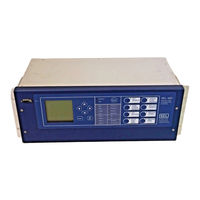SEL SEL-421 Protection Control System Manuals
Manuals and User Guides for SEL SEL-421 Protection Control System. We have 2 SEL SEL-421 Protection Control System manuals available for free PDF download: Instruction Manual, User Manual
SEL SEL-421 Instruction Manual (705 pages)
Protection and Automation System
Table of Contents
-
Array11
-
Array24
-
Applications34
-
Conventions36
-
Examples36
-
Commands37
-
Numbers37
-
Tapped Line54
-
Fault Type61
-
LOP Logic68
-
Settings70
-
Z2F and Z2R71
-
A2 and K271
-
A072
-
Order72
-
E32Iv72
-
Zone Time Delay103
-
Zone Timers105
-
SOTF Options127
-
SOTF Settings127
-
ECOMM Setting129
-
DCB Settings132
-
POTT Scheme133
-
Pott134
-
Pott2134
-
Pott3134
-
Echo135
-
POTT Settings136
-
DCUB Settings143
-
Trip Logic147
-
Trsotf148
-
Trcomm148
-
Timers149
-
Ultr149
-
Retrip Logic158
-
Auto-Reclosing170
-
Logical States170
-
Start (79STRT)170
-
State Diagram171
-
Single-Pole Mode173
-
Three-Pole Mode174
-
Lockout State187
-
Reset State188
-
Manual Closing209
-
PT Connections223
-
Comments242
-
Protection243
-
Automation244
-
Outputs244
-
Power Loss246
-
Settings Change246
-
Latch Bits251
-
Counters258
-
Aliases260
-
Parentheses262
-
Not263
-
And263
-
Or263
-
R_Trig263
-
F_Trig264
-
Comparison265
-
Math Operators265
-
Arithmetic266
-
Sqrt267
-
LN, EXP, and LOG268
-
ASIN and ACOS269
-
Testing271
-
Eia-232276
-
Eia-485278
-
Ethernet Card278
-
Ftp281
-
File Structure282
-
Access Control283
-
Telnet283
-
Using Commands284
-
Command Summary285
-
Access Levels285
-
2Access286
-
Access287
-
Date287
-
Dnpmap287
-
Goose288
-
Help290
-
ID290
-
Memory291
-
Ping291
-
Quit291
-
Status292
-
Time292
-
Data Frame302
-
Timeout308
-
Root Directory312
-
Events Directory313
-
Mb8316
-
Loopback Testing318
-
Initialization321
-
RTD Status Bits323
-
Data Handling326
-
Objects326
-
Access Methods327
-
Function Codes327
-
Data Access329
-
Event Data330
-
Binary Controls331
-
Modem Support332
-
DNP3 Settings332
-
Device Profile336
-
Object List337
-
Default Data Map340
-
Dnp Lan/Wan356
-
Binary Inputs363
-
Analog Inputs364
-
Binary Outputs364
-
Analog Outputs364
-
DNP Map Command364
-
Synchrophasors379
-
Accuracy387
-
Mfrmt390
-
Mrate390
-
Phcomp391
-
PMSTN and PMID391
-
Phnr393
-
Phfmt393
-
Fnr393
-
Numana394
-
Numdsw394
-
Mrtcdly396
-
Rtcrate396
-
Pmumode396
-
Rtcid396
-
Pmid411
-
Object Models419
-
Data Mapping420
-
Mms420
-
File Services421
-
SCL Files421
-
Reports421
-
Datasets424
-
SEL-421 Datasets424
-
GOOSE Quality425
-
GOOSE Processing426
-
Logical Nodes432
-
MMS Conformance447
-
Aaccess460
-
Bname460
-
Breaker460
-
BRE N461
-
BRE N H461
-
Cal462
-
Cascii462
-
Cbreaker462
-
Cbr462
-
Cevent463
-
Cbr Terse463
-
Cev463
-
Cev Ack463
Advertisement
Sel SEL-421 User Manual (318 pages)
Protection,Automation, Control
Table of Contents
-
-
Index14
-
-
-
Preface39
-
User's Guide40
-
Glossary40
-
-
-
Features48
-
Applications52
-
-
-
Jumpers77
-
Connection93
-
Analyze Events125
-
-
-
Test Methods254
-
Relay Self-Tests277
Advertisement

